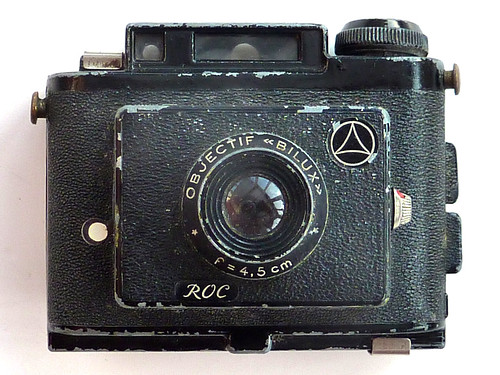Difference between revisions of "Roc"
m (Removed link to the Clic, which isn't the same) |
m (-stub) |
||
| (4 intermediate revisions by 2 users not shown) | |||
| Line 1: | Line 1: | ||
| − | + | ||
<div class="floatright plainlinks" style="margin:0px 0px 20px 20px;"> | <div class="floatright plainlinks" style="margin:0px 0px 20px 20px;"> | ||
{{Flickr_image | {{Flickr_image | ||
| Line 19: | Line 19: | ||
}} | }} | ||
</div> | </div> | ||
| − | The '''Roc''' is a simple viewfinder camera for 36 mm square exposures on 127 film, made by [[IDAM]] in about 1951.<ref name=McK>{{McKeown12}} p421-2.</ref> Some examples of the camera have no exposure controls at all (as in the top picture here); others have an 'I' and 'B' shutter, selected with the knob to the side of the lens in the lower example. Similarly, examples of the camera may have a tripod bush and strap lugs, or not. In either case, the camera has the wide window in the top | + | The '''Roc''' is a simple viewfinder camera for 36 mm square exposures on 127 film, made by [[IDAM]] in about 1951.<ref name=McK>{{McKeown12}} p421-2.</ref> Some examples of the camera have no exposure controls at all (as in the top picture here); others have an 'I' and 'B' shutter, selected with the knob to the side of the lens in the lower example. Similarly, examples of the camera may have a tripod bush and strap lugs, or not. In either case, the camera has the wide window in the top housing: McKeown states that this holds an [[Exposure_meter#Extinction_meters|extinction-type lightmeter]],<ref name=McK/> and it is hard to think of another use for the window, but certainly no optical wedge (or any markings) can be seen in the examples pictured here.<ref>The [http://camerasdownunder.com/gallery/displayimage.php?album=7&pos=131 Brief notes on the Roc] at [http://www.camerasdownunder.com/ Cameras Downunder] also state that there is no extinction meter in that example.</ref> The body of the camera is cast in a metal alloy, 'Zamak',<ref>[https://en.wikipedia.org/wiki/Zamak Zamak] is an alloy containing '''z'''inc, '''a'''luminium, '''ma'''gnesium, and copper ('''K'''upfer in German).</ref> its two halves held together with hinged clips of plated metal. It has a sliding metal cover over the [[red window]]. |
An almost identical camera was sold as the [[Belco]]. | An almost identical camera was sold as the [[Belco]]. | ||
| Line 28: | Line 28: | ||
==Links== | ==Links== | ||
| − | *[http://www.collection-appareils.fr/x/html/page_standard.php?id_appareil=1163 Roc] at Sylvain Halgand's [http://www.collection-appareils.fr/carrousel/html/index.php Collection Appareils] | + | *[http://www.collection-appareils.fr/x/html/page_standard.php?id_appareil=1163 Roc] at Sylvain Halgand's [http://www.collection-appareils.fr/carrousel/html/index.php Collection Appareils] (in French) |
Latest revision as of 07:38, 24 June 2021

|
| ROC without I/B shutter control or strap lugs. image by Peter Kitchingman (Image rights) |

|
| Roc with shutter control and lugs image by Tony Kemplen (Image rights) |
The Roc is a simple viewfinder camera for 36 mm square exposures on 127 film, made by IDAM in about 1951.[1] Some examples of the camera have no exposure controls at all (as in the top picture here); others have an 'I' and 'B' shutter, selected with the knob to the side of the lens in the lower example. Similarly, examples of the camera may have a tripod bush and strap lugs, or not. In either case, the camera has the wide window in the top housing: McKeown states that this holds an extinction-type lightmeter,[1] and it is hard to think of another use for the window, but certainly no optical wedge (or any markings) can be seen in the examples pictured here.[2] The body of the camera is cast in a metal alloy, 'Zamak',[3] its two halves held together with hinged clips of plated metal. It has a sliding metal cover over the red window.
An almost identical camera was sold as the Belco.
Notes
- ↑ 1.0 1.1 McKeown, James M. and Joan C. McKeown's Price Guide to Antique and Classic Cameras, 12th Edition, 2005-2006. USA, Centennial Photo Service, 2004. ISBN 0-931838-40-1 (hardcover). ISBN 0-931838-41-X (softcover). p421-2.
- ↑ The Brief notes on the Roc at Cameras Downunder also state that there is no extinction meter in that example.
- ↑ Zamak is an alloy containing zinc, aluminium, magnesium, and copper (Kupfer in German).
Links
- Roc at Sylvain Halgand's Collection Appareils (in French)